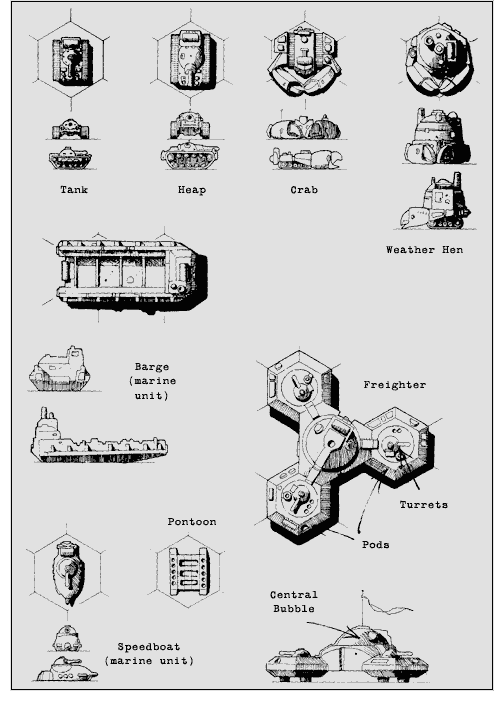
SUMMARY
Your goal is to leave Full Metal Planète carrying as much ore and units as possible.
CONTENTS
1 playing field representing one sector of the Full Metal Planète
15 tide cards
84 metal pieces:
- 4 Freighters
- 12 turrets
- 8 crabs
- 4 Weather Hens
- 32 tanks
- 4 Heaps
- 8 high-speed motorboats
- 4 barges
- 8 pontoons
100 colored markers for identifying which unit is controlled by which Freighter
8 colored cubes to count the action points saved by each player
1 turn marker cube
1 rulebook
100 pieces of ore
1 black plastic box with many uses - the box is a current turn indicator, a cemetery for destroyed unites, a pool for materal yet to be created, and a display unit for tide cards
MISSION SUMMARY
You land your Freighter on Full Metal Planète on a mission which will last 21 or 25 turns.
On every turn you have a certain number of action points which you can use - but no matter how many action points you have, each turn lasts for maximum of three minutes.
In each turn the you can do the following:
- to collect ore - to be used in your Weather Hen or to be stored into your Freighter
- to create additional units with Weather Hen to help you collect more ore
- to weaken the enemies with armed units
- to threat or hinder enemies' movement by occupying strategically important parts of the planet
- to capture one or more Freighters - and thus increase the number of units under countrol, get additional actions points and to take off at the end of the game with extra Freighters and their contents (ore and units)
- hold peace negotiations or to discuss actions againts enemies who are too agressive
THE PLANET
THE PLAYING FIELD
The playing area is composed of 851 hexes (only complete hexes are used).
The dotted lines mark the zone boundaries for arriving Freighters. The open sea is blue, the plains are light brown, the reefs are blue with ligh brown dots, swamps are light brown with blue dots and mountains are gray. The type of each hex depends of its dominant color: if you are not sure, look at the maps.
THE ORE
The ore is spread all over the playing field. Ore can be transported into the Freighter to gain points or it can be used by Weather Hen to transform it to additional units.
A hex with ore is occupied. The hex can not be used in any way before the ore is piced up from the hex.
With low tide, the ore can be piced from any type of hex. With normal tide, the ore can not be picked up from reefs. With high tide, ore can not be picked up from reefs nor swamps.
The ore can be manipulated in following ways:
- load it into Freighter from adjacent hexes
- load, transport or unload it with crab (can carry up to 2 ores) or with barge (can carry up to 4 ores)
- load, transport, unload or transform it with Weather Hen (only one ore at a time)
- destroy it with two destroyers (tank, high-speed motorboat, turret, Heap)
THE TIDES
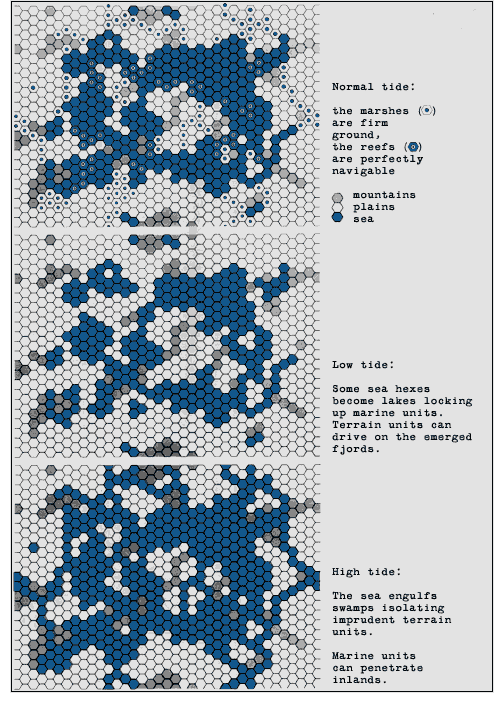 Every turn is subjected to one type of weather: normal, low or high.
Every turn is subjected to one type of weather: normal, low or high.
The management of the 15 tide cards (five normals, five lows and five highs) will be explained in the chapter "start of mission".
- normal tide: swamps = plain, reefs = sea
- high tide: swamps and reefs = sea
- low tide: swamps and reefs = plain
Consequences:
When the tide is low, reefs can not be used by marine vehicles (high-speed motorboats and barges) and terrain vehicles can use them.
When the tide is high, swamps can not be used by terrain vehicles and marine vehicles can use them.
When the tide is normal, swamps are plains, and reefs are sea: swamps can be used by terrain vehicles and reefs can be used by marine vehicles.
The units surprised by change of tide are neutralized:
- Marine vehicles are neutralized if they are on reef or swamp when the tide is low.
- Marine vehicles are neutralized if they are on swamp when the tide is normal.
- Terrain vehicles are neutralized if they are on reef when the tide is normal.
- Terrain vehciles are neutralized if they are on reef or swamp when the tide is high.
It is possible to voluntarily neutralize an unit: in that case, the unit is neutralized and must top on the exact hex which is temporarily unusable by it.
| HOW TIDE EFFECTS THE PIECES | ||||
| REEFS | SWAMPS | |||
| marine units | terrain units | marine units | terrain units | |
| LOW TIDE | disabled | operational | disabled | operational |
| NORMAL TIDE | operational | stuck | disabled | operational |
| HIGH TIDE | operational | stuck | operational | stuck |
PLAY MECANICS
ACTION POINT SYSTEM
Basic credit
Each player has a basic credit of fifteen action points, which he or she can spend to move as many parts as he or she wishes.
Cost in action points for each action:
- moving a unit from one hex to adjanced hex: 1
- loading or unloading an unit or a piece of ore: 1
- creating a new unit with Weather Hen (assuming that coverter is already carrying ore): 1
- re-enterint or leaving Freighter; 1 (barge, which occupies two hexes, also requires only one action point to load/unload)
- destruction of an unit or a piece of ore: 2
- rebuilding a turret: 2 (per turret)
- final takeoff: 1, 2, 3 or 4 (depending on Freighter's condition).
Bonus:
- Player who uses only 10 points out of his 15 saves 5 action points (15-10=5)
- Player who uses only 5 points out of his 15 saves 10 action points (15-5=10)
- Maximum number of saved action points is 10. It is possible, but not mandatory, to use all saved points on same turn.
- If player saves 5 or 10 points, he picks up a colored cube for each 5 actions points he saves, and places the cube in front of him.
- Turn saving allows players to have maximum of 25 points per turn (base credit, 15 + maximum saves, 10 = 25 action points).
- When saved actions points are used, the colored cube(s) are returned to the box
Super-bonus:
- Each conquered Freighter increases the basic credit of the occupant five points (in this case, colored cubes are not used)
- Example: owner of three Freighters (original+2 conquered) who has saved 10 action poins can play basic credit+bonus+10 points:
- basic credit 15
- bonus (saved) 5+5
- super-bonus 10
- Total 35 points!
Attention
- all actions are done DEFINITELY
- if an unit performs actions that are agains the rules, only the points preceding that operation are done and the player resumes from the hex/action which he or she before the impossible operation
- very unit or item occupies one hex: two units or items can never occupy the same hex (except units on pontoons and transporters carrying items)
- the barge is the only unit that occupies two hexes: any movement that makes it to cover a new hex costs one action point.Barge can travel both forwardsand backwards, so it is not required to spend action points to just rotate the barge 180 degrees.
TIME
Each player has maximum of three minutes time in which to make his or her actions. After that time the player can not perform any actions. If unit is being moved when the time runs ount, it must remain on the hex where it originally was located. Armed units can complete their firing commands if the firing units are already placed correctly.
After a turn has ended the next player's turn will immediately start. Timing is performed by the player who has just finished his or her turn. If a player asks how much time is remaining on his or her turn, the question must be answered. All players should be able to see the stop watch at all times.
It is very important to stricly stick to the three-minutes-rule, even if it creates errors: panic is one of the ingredients of Full Metal Planète.
TRANSPORTERS
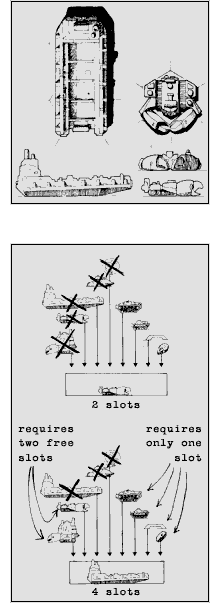
BARGES, CRABS LOADING AND UNLOADING
There are two kinds of transporters:
- the barge (has 4 cargo slots)
- the crab (has 2 cargo slot)
Transportable elements are:
- ore, tank, Heap, pontoon which occupy one cargo slot each
- Weather Hen and crab which occupy two cargo slots each
Loading is performed from transporter's adjacent hex.
Unloading is performed to transporter's adjacent hex.
Loading and unloading costs always 1 action point.
To load or unload a crab which carries item(s) costs only 1 action point. To modify its contents while on barge does not cost any actions points.
Any unit carried by any transporter is automatically neutralized.
The target hex where units or items are unloaded must be empty or occupied by a pontoon or another transporter which has enough free cargo slots to accept the unit or item.
To re-enter or leave the Freighter with a transporter that carries items costs only 1 action point.
A transporter can not load or unload unit or item from/to hex if that hex is under unfavorable fire.
Unloaded units do not have to be moved.
It is not possible to unload anyting in open sea.
Items and units can be unloaded onto sunken reefs or swamps, but in that case the items and units will become neutralized until the tine changes favorably.
Units can not be moved on a sunken hex that contains (thus neutralized) units or items (except pontoons).
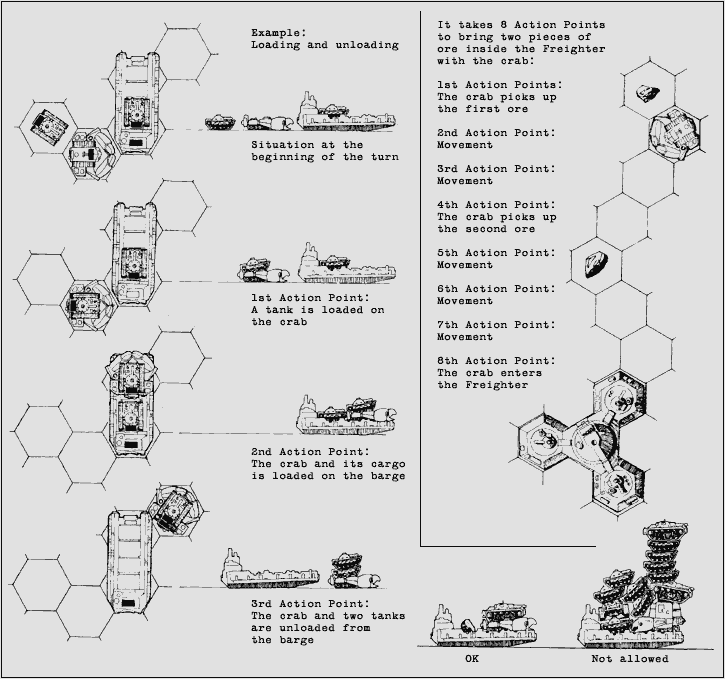
WEATHER HEN
MANUFACTURING UNITS
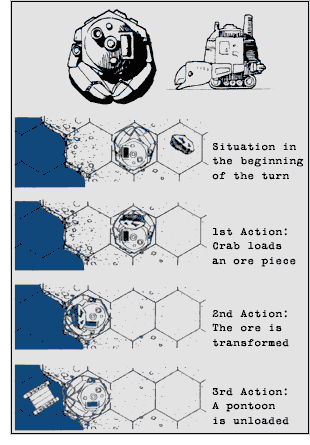 The Weather Hen can create new parts: it stops on a hex nex to an ore, loads the ore and lays a tank, brige or crab taken from the box to an adjacent hex. The creation of a new unit costs two action points: one point to load the ore and another one to lay the item.
The Weather Hen can create new parts: it stops on a hex nex to an ore, loads the ore and lays a tank, brige or crab taken from the box to an adjacent hex. The creation of a new unit costs two action points: one point to load the ore and another one to lay the item.
Weather Hen can load ore, then move, and this way lay the new unit further away, even in another turn.
When Weather Hen loads or lays units it must follow the same rules as a normal crab.
One Weather Hen can lay two parts in one turn. It can not lay two crabs or two bridges in the same turn.
If so required, Weather Hen can unload unconverted ore (so it can be used as a normal transporter for ore).
Note: The amount of reserve units in the box is designed so that in the beginning each player can create the same units. It will then be a question of wether to try to bring the maximum amount of ore into the Freighter or to try to get stronger by transforming it to more units.
WEATHER PREDICTION
When the tide changes, any player who has an operational Weather Hen can check out the future tide: a player who has two Weather Hens can look two tides etc.
Coverter is inoperative inside Freighter, on a barge, when under fire or when disabled to stuck in a hex.
PONTOONS
 Pontoons, inert units, are used to cover reef, swamp or open sea hexes.
Pontoons, inert units, are used to cover reef, swamp or open sea hexes.
A pontoon can be unloaded or loaded from/to transporter (or from the Freighter), whatever the tide.
One pontoon is used exactly like a plains-type hex.
Pontoon must always touch at least one ground hex.
It is possible to connect many pontoons together, as long as the first one touches ground hex. In this case, if the first pontoon is destroyed or loaded, the remaining pontoons are destroyed. Also, if the hex to which a pontoon is connected sinks because of weather change, the whole pontoon structure is lost.
If a pontoon is destroyed, everything on top of the pontoon is also destroyed.
If a pontoon is under enemy fire, it can not be used or loaded.
A pontoon is a neutral unit. Once unloaded, it can be used by any terrain vehicle. Because of that, an enemy transporter can load a pontoon without capturing it first.
If a pontoon is unloaded onto firm ground, it can still be used.
High-speed motorboats and barges can not travel to a hex that contains a pontoon.
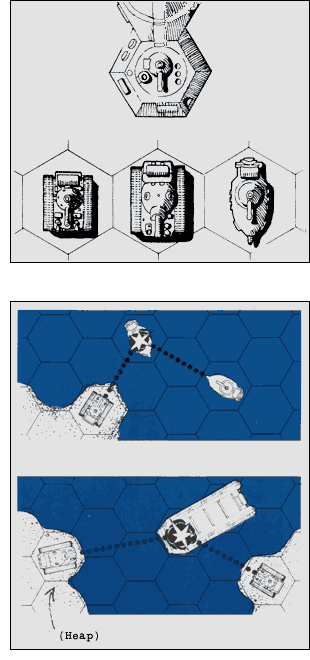
DESTROYERS
Destroyers can destroy any element (unit or ore), except Freighters and their contents (however, Freighters' turrets can be destroyed). Destroyers are used to destroy, capture, push back enemies and to defend. There are four types of destroyers: high-speed motorboats, tanks, long shooting range supertank T-99 familiarly called "Heap" and the turrets (fixed).
DESTROYING ELEMENTS
Principle: any element reached by the simultaneous shooting of two destroyers of the same player is destroyed and put at the cemetery.
Mechanism
Turret, tank and high-speed motorboats can reach two hexes from their own position.
Heap can reach a target three hexes away from its own position.
Normal tank located on a mountain hex can reach a target three hexes away (even if the target is on another mountain).
Heap, even if transported, can never go on a mountain hex.
When a turn ends, two tanks can not be parked on two adjacent mountain hexes.
A destroyer can shoot over any obstacle or terrain, including sea, ore, Freighter, mountain etc.
A destroyer has ammunition to fire only two times twice per turn (other actions can occur between the two shots). Every destroyer is restocked with ammunition at the very start of the following player's turn.
Destroyers can not destroy own units except pontoons.
If destroyers open fire at a hex, everything on that hex is destroyed.
Remember: it is always required to have two destroyers to destroy any target. A single destroyer can not destroy nor defend anything. Because of this, it costs 2 action points to destroy any target: one point per destroyer.
Definition: a hex is "under favorable fire" when it is in range of two or more destroyers of the same player.
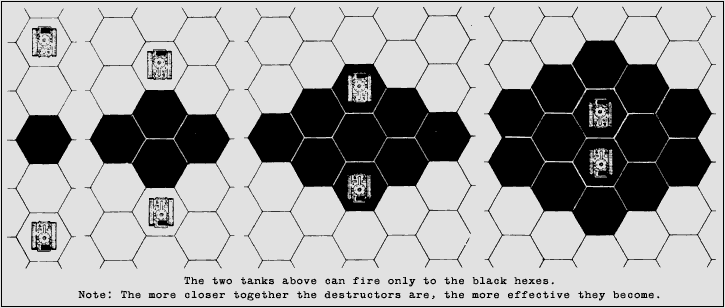
ATTACKING A SECTOR DEFENDED BY UNFAVORABLE FIRE
When a player operates in such a sector, the destroyers never arrive at the same time (even tho the firing is simulatenous). There is always the first and the second. The first unit can never be placed under unfavorable fire. The second unit can move inside the unfavorable fire zone if it will stop at once when inside the zone, and instantly open fire (with the first unit). After firing the shot, the second unit must have destroyed enough defenders not to be under unfavorable fire any longer. Only then the attacking player can move the second unit further.
The "Theory of the Second Unit" can be summarized as follows: a destroyer can move under unfavorable fire if after moving inside the fire zone it can remove the fire zone by destroying the enemy.If the second unit arrives transported, it must be unloaded outside the fire zone and then it must - by its own means - move inside the fire zone.
(Not all attacks use the "Theory of the Second Unit" - if, for example, two destroyers are targeting an undefended unarmed unit, then there are no fire zones and the target can be destroyed more easily)
CAPTURING UNITS
Principle: two destroyers owned by the same player, when in contact with an unit of different color, can capture the unit.
The capture takes place instantly by changing the captured unit's color marker. Capturing costs 1 action point.
When capturing an unit, the destroyers performing the capture and the unit being captured must be outside of an unfavorable fire zone (a player can thus protect a unit from capture by covering it with a fire zone).
The captured unit is immediately operational for any action.
If a destroyer is out of ammunition, it can still capture a unit(s).
If a transporter is captured, all its cargo is also automatically captured and change color without need to spend any any additional action points.
Remember that it is not neccessary to capture a pontoon in order to use it.
The capture of Freighter is very different.
RETREAT AND NEUTRALIZATION
At the end of a turn, destroyers can hold units under their fire zone without destroying or capturing them.
In this case, on his/her turn the threatened player can try to retreat: he/she can move each unit one hex, but only if the hex where the unit is moved is outside of the fire zone.
If the player decides to retreat, he/she must do so before performing any other actions.
An unit not able to move outside the unfavorable fire is neutralized and can not do anything.
If so happens, the only way to de-neutralize the unit(s) is to destroy the enemy with other destroyers.
As soon as destroyer has succesfully de-neutralized other unit(s), it can not move any more until the end of its turn. When the turn changes, the other player can try to destroy or capture the de-neutralized.
Turrets can not be neutralized. They can shoot, even when inside an unfavorable fire zone.
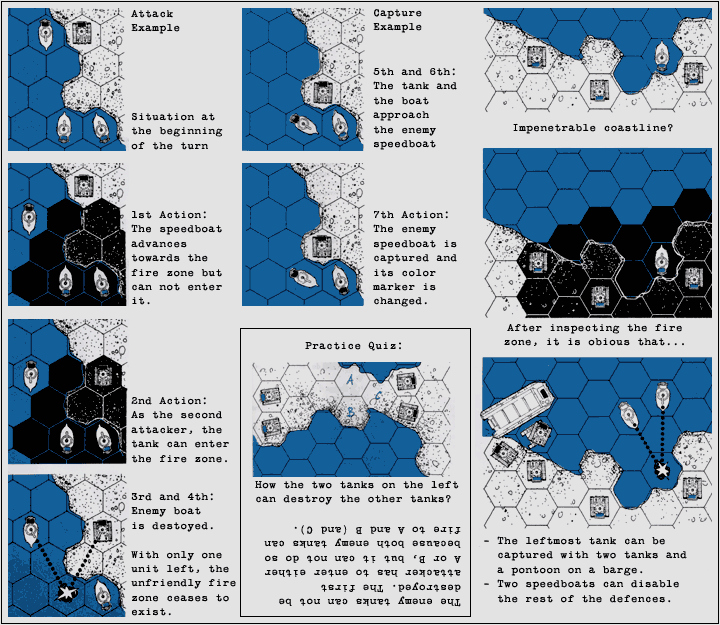
THE FREIGHTER
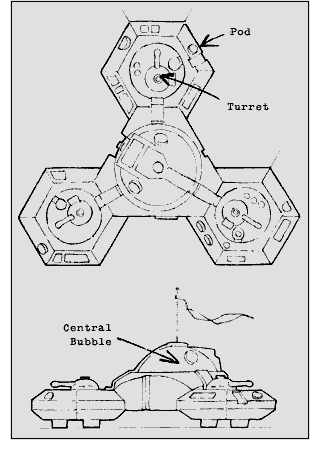 The Freighter, composed of a central bubble and three pods with turrets, occupies four hexes on the map.
The Freighter, composed of a central bubble and three pods with turrets, occupies four hexes on the map.
Besides its turrets, the Freighter and its carge are indestructable. Freighter is the home (and the only starting point) for all its the units.
Any element that is inside the Freighter must be placed outside the map, visible to all players.
Freighter can only land on plains or on swamps (otherwise weather does not have any effect on it).
ENTERING AND LEAVING THE FREIGHTER
All units re-enter and come out of the Freighter from one of its three pods to any suitable adjacent hex (units can not exit via the central bubble).
Once ore is loaded into Freighter, it can not be unloaded nor transformed to other units.
If a loaded transporter enters or exists Freighter, it only costs 1 action point. Loading or unloading the transporters do not cost points when done inside the Freighter. On the same turn, an unit can enter Freighter via any pod and exist via any available pod.
The Freighter can be considered as a normal transporter, BUT
- units can enter or come out by any pod located under unfavorable fire (if the target hex is not inside a fire zone)
- units can not exist via pod if pod's turret is destroyed
- unit (or ore) can enter via pod even if that pod's turret is destroyed
CAPTURING THE FREIGHTER
When its three turrets are destroyed, the Freighter and all its units are passed under the control of the first player who manages to enter the Freighter with a destroyer. In this case, the units preserve their original color.
As soon as the Freighter is captures, the player who performed the capture gets 5 more action points to his basic credit. If desired, those extra 5 action points can be used at once.
A player who controls several Freighters continues to play only one time, in his turn.
If a player loses one of his/her Freighters, his/her basic credit decreases by five points (example:if a player has three Freighters but loses one of them, his/her basic credits decrease from 25 to 20 points).
Any player who loses his/her Freighter automatically loses the game. In that case his/her extra bonus cubes are returned to the box.
The player who capture the Freighter can rebuild the turrets on the damaged Freighter:
- without needing ore or Weather Hen
- in one or more turns
- never on a pod under unfavorable fire
- to rebuild a turret costs 2 action points
- a rebuilt turret can fire immediately
Example: A player captures a Freighter and thus acquires new units under his command. In this case, if some of the new units are inside a unfriendly fire zone, the new owner of the Freighter must, before any action, put the units of his new army out of unfriendly fire zone. The parts which could not moved out of the fire zone are neutralized.
Remarks:
- Even if all three turrets are destroyed, the Freighter still remains uncaptured as long as a hostile destroyer does not infiltrate the Freighter.
- The capture of a Freighter is a unique case in which a hostile unit can go inside a friendly unit
- As usual, the capturing destroyer can enter the Freighter from a location that is outside of an unfriendly fire zone...
- ...but, as with all other units, it can enter via a pod that is inside of an unfriendly fire zone.
CHANGE OF COLOR
The color markers of unit are receivers which obey only one transmitter: the Freighter of the same color.
This mean that there are two ways to capture units:
- normal capture
- any unit that has the same color as a captured Freighter obeys the player who captured and controls the Freighter
A Freighter always preserves its original color (its transmitter), even if it is captured by another player.
MISSION START
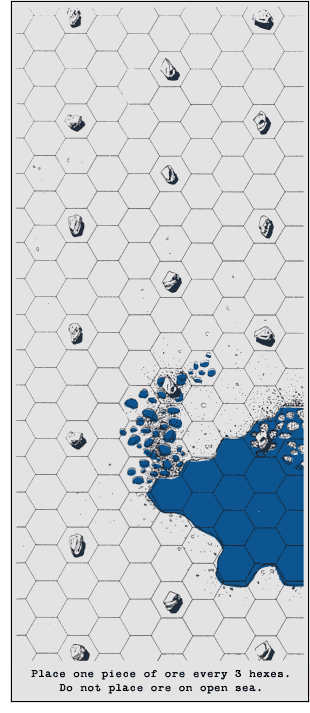 Spread ore all over the map, one piece of ore every three hexes. Then remove all the ore that are placed on open sea hexes.
Spread ore all over the map, one piece of ore every three hexes. Then remove all the ore that are placed on open sea hexes.
The reserve: The units created by Weather Hens will be drawn from the common reserve, which must contain:
- if 2 or 4 players are playing: 16 tanks, 4 crabs and 4 pontoons
- if 3 players are playing: 12 tanks, 3 crabs and 3 pontoons
FIRST TURNS
Turn 1: Arrival of the Freighters
Put the turn indicator cube into the first turn slot.
Each player has three minutes in which to land his/her Freighter, maked with his/her color, inside a "landing zone": one of the two islands or a ground section between two dotted lines. A Freighter occupies four hexes, and the following rules must be followed when placing the Freighter: leave at least one-hex-wide passage at the edge of the map; land only on plains or swamps (or mx of both). Two Freighters can not land on adjacent landing zones (an island is not a contiguous zone).
- The selected landing zone (including reef hexes touching the coast) is cleared of ore.
Check that you have all the units in front of you (not on the map): a barge, a crab, a Weather Hen, two high-speed motorboats, four tanks, one Heap and a pontoon. Mark your units with your color.
Turn 2: Deployment (without action points)
Move the turn indicator cube into the second turn slot. You have three minutes to deploy all or some of your units on the ground. You can place your units on any suitable hexes, as long as the hexes are inside your landing zone. The bridge and marine vehicles must touch the cost of their Freighter's landing zone. Transporters can be deployed loaded with other units.
On this turn, the tide is considered normal, but beware that it might change for the worse!
Turn 3: Five Action Points
Move the turn indicator cube into the third turn slot.
Decide which player begins. The turns will be taken in clockwise order.
Take othe first tide card from the deck and place it visible to the "current tide"-slot. That card indicates the weather for this third turn. The players whose Weather Hen is operational (not inside Freighter, on a transporter or stuck/disabled/neutralized) may look aht the second card which indicates the tide for the next. If every player has their Weather Hen functioning, the cards can be simply turn over, visible, on the top of the "future tides"-deck. After that, the turn begins:
You perform your actions, one by one, with 5 action points and three minutes.
Turn 4: Full Hassle, Ten Action Points
The "future tide"-card becomes "current tide"-card.
Everyone who has an operational Weather Hen may check the next tide.
Every player can use 10 action points.
Turn 5
Did you remember to move the turn indicator?
From now on, every player can use up to 15 action points.
The "future tide"-card moves to "current tide" and the next one is checked by those two can do so. This contiunes until the 25st turn (at the beginning of 11th and 19th turn when the "future tides"-deck is empty you must shuffle all the cards - except the "current tide"-card - and take out six cards before looking at the future tide, ect.)
Turn 6
Turn indicator, tides, 15 action points, action heats up as you become a true Full Metal Pilot.
Look out for those players who have already saved action points!
MISSION END
The 21st turn's departure is done in the following way: at the beginning of the 21st turn, every player secretly puts an unit or a piece of ore in his hand. The unit means that the player's Freighter will remain on the planet until the 25th turn; the ore means that the player's Freighter leave immediately.
Each player stretches his/her arm(s) to the middle of the map, and everyone opens their hands at the same time.
Those who decided to leave take off immediately, without playing their turn, with what their Freighter contained at the end of the 20th turn.
A player who has more than one Freighter can leave take off some of his/her Freighters and leave other Freighters on the planet. If a player has, for example, two Freighters and takes off one of them, his/her basic credit will drop from 20 action points to 15 action points.
The players who left can count their score: 2 points per ore, 1 point per every unit in the Freighter (each turret is worth 1 point). The identically colored units that the players left behind on the planet are neutralized: the remaining players can come to destroy or capture them.
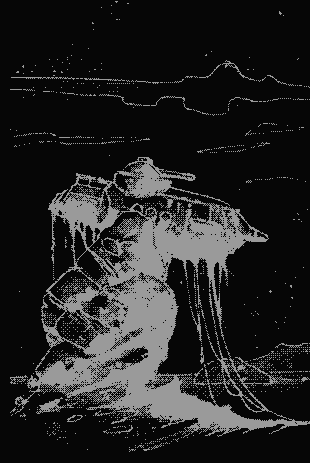 Turn 25
Turn 25
If one or more players decided to remain on the planet, they play the 21st turn and continue as usual.
They must take off their Freighters on turn 25, after having played their own turn.
Caution: by playing the 25th turn, it is possible not to have enough action points at the end of the turn to lift off. Take off requires the player to have at least 1 action point, and 1 extra action point for every broken turret. For example a Freighter with two broken turrets needs 1+(1+1)=3 action points to take off.
After the 25th turn every player counts their points the same way like those did who took off on the 21st turn.
The player who has the most points wins.
If two or more players have the same amount of points, the one who has the biggest load of ore wins.
Remember: Any used action point is lost forever. If, after having spent all the action points, a player can not take off his Freighter, it will remain on the Full Metal Planète where it will rust until the end of the time.